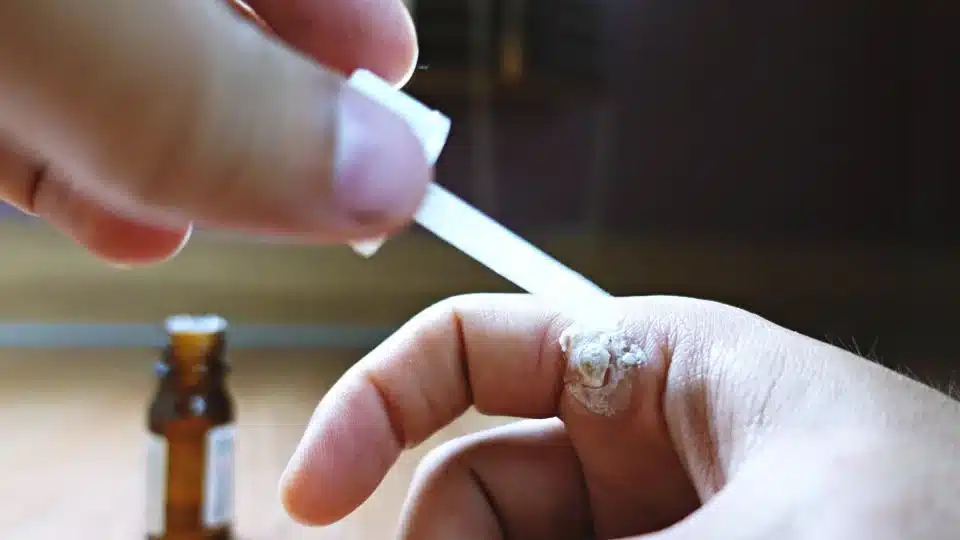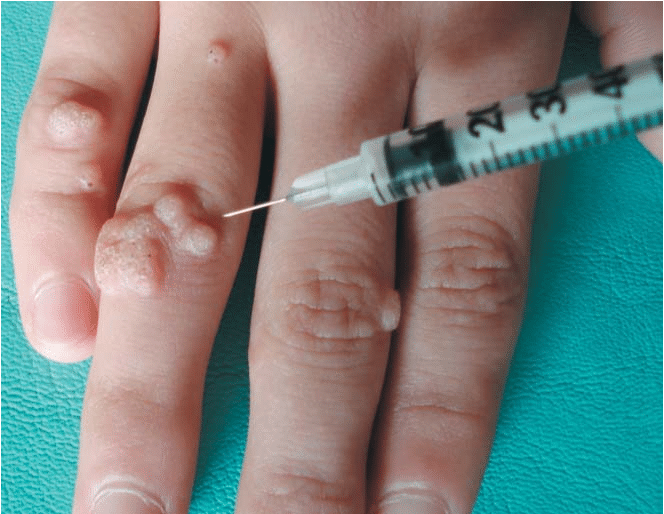Warts are a common skin condition that can occur anywhere on the skin's surface. They can be smooth, rough, raised or flat, and may have a bumpy or cauliflower-like texture. There are several types of warts, including common warts, flat warts, plantar warts, facial warts, and genital warts.
Warts are caused by the human papillomavirus (HPV), which is a common skin infection. There are more than 100 different strains of HPV that can cause warts, but the most common types that cause warts on the hands and feet are types 1, 2, 4, 27, and 57. Genital warts are caused by types 6 and 11 of the HPV virus.
In Singapore, warts are particularly common among young adults and children. Warts can spread from person to person through skin-to-skin contact or by coming into contact with contaminated objects, such as towels, shoes, or shower floors.
For more information on how warts are caused and how they can be prevented, you can read our detailed guide on how you get warts and how to remove them.
Warts can be visually unappealing and cause embarrassment, especially when they appear on visible parts of the body, such as the hands, face, or feet. They can also be uncomfortable or painful, particularly when located in areas with pressure or friction, such as the soles of the feet or between the toes.
Another reason for wart removal is that warts can be contagious. They can spread from one person to another through direct contact with skin or by sharing personal items like towels or shoes. By removing warts, individuals can prevent the spread of the virus to other parts of the body or to other people.
Lastly, some individuals may opt for wart removal because of the potential health risks associated with certain types of warts. For instance, genital warts caused by HPV types 6 and 11 can increase the risk of developing cervical, anal, or penile cancer.
Removing warts can help individuals to avoid these complications, regain their confidence, and enjoy healthy skin. Laser wart removal services in Singapore are one of the most effective ways to remove warts.

Wart removal creams target the virus that causes warts by causing the skin cells around the wart to die and peel off. There are various types of creams such as acids, immune system modulators, vitamin A derivatives, and others. It may take weeks or even months for topical medications to effectively remove warts. In some cases, these medications may not even work, particularly for larger or long-standing warts. Be cautious when using topical wart removal creams as they may cause skin irritation, pain, allergic reactions, and other complications like pigmentary changes or scarring.


Cryotherapy wart removal involves the application of liquid nitrogen to freeze and subsequently eliminate warts. During the procedure, the extreme cold causes the wart to break down, leading to scabbing and eventual shedding. While cryotherapy can be used for removing smaller warts, it is difficult to be very accurate with cryotherapy. Cryotherapy may be less effective for deeper or larger warts, necessitating multiple sessions. Additionally, it may cause complications such as blistering, skin colour changes, and scarring.
CO2 laser is strongly absorbed by water in cells under the skin. Laser energy vaporizes a layer of skin cells together with a surrounding zone of coagulation. Ultrapulse CO2 produces very short pulses of laser energy with high peak power. The amount of tissue vaporization vs coagulation can be tailored, allowing for vaporization of only the abnormal tissue without causing too much collateral damage. The entire process results in successful wart removal treatment.
High-frequency radiofrequency is strongly absorbed by water in cells causing vaporization or coagulation depending on the waveform. It can be used to dissect out warts or coagulate them.
Vascular lasers, such as pulsed dye, gold, long-pulsed NdYAG, or KTP lasers, can be used to remove warts by targeting the blood vessels that supply the wart. The laser emits a specific wavelength of light that is absorbed by the blood vessels in the wart, causing them to heat up and coagulate. This cuts off the blood supply to the wart, leading to its eventual death and removal. Vascular lasers have a relatively low risk of scarring compared to other wart removal methods and are popular amongst patients looking for 'scarless' wart removal. However, they have relatively limited penetration and clearance so not all warts are suitable for wart removal with vascular lasers and multiple sessions may be required.

Surgical excision involves physically removing the wart using a scalpel or other surgical instrument, is generally reserved for more severe or difficult cases of warts, and is not typically a first-line treatment.
Warts that are unusual in appearance or do not respond to other treatments may need to be surgically removed and sent for a biopsy to rule out the possibility of skin cancer.
Wart removal injections do not directly remove the wart but work by either damaging the wart tissue or stimulating the body’s immune system to fight off the wart. They’re less invasive and require less recovery time than destructive treatments, posing less risk of scarring.
However, they also have some drawbacks such as requiring multiple sessions, having a relatively higher failure rate, potentially being more expensive overall, and causing more systemic side effects like fever.

Warts can be pesky and difficult to completely eliminate. Older treatments have clear disadvantages: Topical wart removal creams have limited effectiveness while cryotherapy is imprecise and requires multiple sessions.
While ablation with lasers or radiofrequency is more nuanced and can completely remove the growth in 1-2 sessions, vaporizing deep-seated warts may still lead to scarring. This is particularly problematic in visible areas such as the face or areas with poor healing such as over joints. Vascular lasers have a better risk profile and a much lower risk of scarring but require multiple sessions and may struggle to eradicate deeply rooted warts.
Dr Wan is constantly thinking about how to innovate novel wart removal techniques that give more complete wart removal while preserving as much normal tissue as possible to prevent scarring. He particularly enjoys tackling difficult cases such as warts in complicated locations or large raised warts.
Patients' major concerns with wart removal are that the wart may recur or that scarring could result. To ensure the best outcome, it is important to ensure that all the abnormal wart tissue is removed while limiting the collateral damage to the surrounding tissues. To achieve this, Dr Wan uses methods that have a high degree of control over tissue damage. For example, ultrapulse CO2 and high-frequency radiofrequency can provide tunable amounts of ablation and coagulation to vaporize only the infected cells, while vascular laser mainly damages the blood supply to the infected cells. Fine control over the destruction of abnormal tissue limits collateral damage and the risk of complications such as scarring or post-inflammatory hyperpigmentation (PIH). Combination treatments use multiple lasers to overcome the limitations of each modality, producing lower recurrence and scarring risks, and are particularly suitable for complicated warts or cosmetically sensitive areas such as the face.
Wart removal injections are an alternative to destructive wart removal treatments that may work better in some cases such as difficult locations, recalcitrant, large, or multiple warts. However, they may not be the best approach for simpler cases.

FOUNDER / MEDICAL DIRECTOR

Removing warts on the face can be tricky as the face is the most visible part of the body. While wart removal on facial skin tends to heal well, minimizing the risk of scarring from wart removal is of relatively more importance compared to wart removal on other parts of the body.
Hence, many patients prefer the precision of vascular lasers or ablative lasers. Vascular lasers minimize the risk of scarring and downtime, while ablative lasers are able to remove most warts within a single session. Combining multiple lasers can decrease the chances of recurrence, the number of sessions required as well as the risk of scarring.
Plantar warts grow on the soles of the feet. The pressure from walking often causes the wart to grow inward, making it painful to walk. Plantar warts can be difficult to treat as they tend to be thicker and go deeper than warts on other parts of the body. Wart removal wounds on the soles can cause relatively more functional limitations in day-to-day life, such as difficulty walking due to discomfort from the raw area. The skin on the soles also tends to heal more poorly and slowly than other parts of the body.
Hence, vascular laser tends to be preferred for plantar wart removal as it has the easiest recovery with no painful raw areas to heal. However, it may need to be repeated a few times for full clearance.
Genital warts appear on the genitals, anus, or surrounding skin. They may be sexually transmitted or passed on through direct skin-to-skin contact. As genital warts can be unsightly and can be passed from person to person during vaginal and anal sex, most patients prefer to use wart removal treatments that work more quickly without the need for multiple sessions. Hence ablative lasers and radiofrequency ablation are more often chosen over vascular lasers.
Wart removal costs in Singapore can range widely from less than $100 to more than a thousand dollars. The price of wart removal depends strongly on the chosen medical aesthetic wart removal method, the number of warts treated, and the complexity of the wart removal.
Topical medication should be adhered to in order to reduce the risk of complications and recurrence after wart removal. The treated area should be monitored closely and any recurrences should be treated early to minimize the risk of the lesions seeding new ones. Avoid touching any existing or suspected warts and keep them covered until treatment can be performed, preferably early.
Address:
1Aesthetics, Medical & Surgery
#14-90 The Central Tower 1
8 Eu Tong Sen Street
Singapore 059818
Mon-Fri 9 AM to 7 PM
Sat 9 AM to 3 PM
Phone / WhatsApp:
+65 66125173 / +65 84899962
Email:
[email protected]